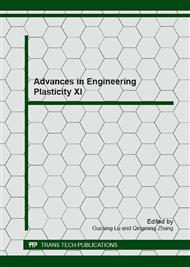[1]
V.S. Deshpande, N.A. Fleck, M.F. Ashby, Effective properties of the octet-truss lattice material, J. Mech. Phys. Solids 49 (2001) 1747-1769.
DOI: 10.1016/s0022-5096(01)00010-2
Google Scholar
[2]
A.G. Evans, J.W. Hutchinson, M.F. Ashby, Multifunctionality of cellular metal systems, Prog. Mater. Sci. 43 (1998) 171-221.
Google Scholar
[3]
H.N.G. Wadley, Multifunctional periodic cellular metals, Philos. Trans. R. Soc. A-Math. Phys. Eng. Sci. 364 (2006) 31-68.
Google Scholar
[4]
L.J. Gibson, M.F. Ashby, Cellular Solids: Structure and Properties, Cambridge University Press, Cambridge, (1997).
Google Scholar
[5]
S. Torquato, L.V. Gibiansky, M.J. Silva, L.J. Gibson, Effective mechanical and transport properties of cellular solids, Int. J. Mech. Sci. 40 (1998), 71-82.
DOI: 10.1016/s0020-7403(97)00031-3
Google Scholar
[6]
S.D. Papka, S. Kyriakides, Experiments and full-scale numerical simulations of in-plane crushing of a honeycomb, Acta Mater. 46 (1998), 2765-2776.
DOI: 10.1016/s1359-6454(97)00453-9
Google Scholar
[7]
A.J. Wang, D.L. McDowell, Yield surfaces of various periodic metal honeycombs at intermediate relative density, Int. J. Plast. 21 (2005), 285-320.
DOI: 10.1016/j.ijplas.2003.12.002
Google Scholar
[8]
Y.H. Zhang, X.M. Qiu, D.N. Fang, Mechanical properties of two novel planar lattice structures, Int. J. Solids Struct. 45 (2008), 3751-3768.
DOI: 10.1016/j.ijsolstr.2007.10.005
Google Scholar
[9]
C. Chen, T.J. Lu, N.A. Fleck, Effect of imperfections on the yielding of two-dimensional foams, J. Mech. Phys. Solids. 47 (1999), 2235-2272.
DOI: 10.1016/s0022-5096(99)00030-7
Google Scholar
[10]
J.L. Grenestedt, Influence of imperfections on effective properties of cellular solids, Mater. Res. Soc. Symp. Proc. 521 (1998), 3-13.
DOI: 10.1557/proc-521-3
Google Scholar
[11]
M.J. Silva, W.C. Hayes, L.J. Gibson, The effects of non-periodic microstructure on the elastic properties of 2-dimensional cellular solids, Int. J. Mech. Sci. 37 (1995), 1161-1177.
DOI: 10.1016/0020-7403(94)00018-f
Google Scholar
[12]
D.D. Symons, N.A. Fleck, The imperfection sensitivity of isotropic two-dimensional elastic lattices, J. Appl. Mech. -Trans. ASME 75 (2008), 051011.
DOI: 10.1115/1.2913044
Google Scholar
[13]
J.S. Huang, L.J. Gibson, Fracture-toughness of brittle honeycombs, Acta Metall. Mater. 39 (1991), 1617-1626.
DOI: 10.1016/0956-7151(91)90249-z
Google Scholar
[14]
S.K. Maiti, M.F. Ashby, Fracture-toughness of brittle cellular solids, Scripta Metall. Mater. 18 (1984), 213-217.
DOI: 10.1016/0036-9748(84)90510-6
Google Scholar
[15]
N.A. Fleck, X.M. Qiu, The damage tolerance of elastic-brittle, two-dimensional isotropic lattices, J. Mech. Phys. Solids 55 (2007), 562-588.
DOI: 10.1016/j.jmps.2006.08.004
Google Scholar
[16]
F. Lipperman, M. Ryvkin, M.B. Fuchs, Fracture toughness of two-dimensional cellular material with periodic microstructure, Int. J. Fract. 146 (2007), 279-290.
DOI: 10.1007/s10704-007-9171-5
Google Scholar
[17]
F. Lipperman, M. Ryvkin, M.B. Fuchs, Nucleation of cracks in two-dimensional periodic cellular materials, Comput. Mech. 39 (2007), 127-139.
DOI: 10.1007/s00466-005-0014-9
Google Scholar
[18]
L.I. Slepyan, Feeding and dissipative waves in fracture and phase transition I. Some 1D structures and a square-cell lattice, J. Mech. Phys. Solids 49 (2001), 469-511.
DOI: 10.1016/s0022-5096(00)00064-8
Google Scholar
[19]
L.I. Slepyan, Feeding and dissipative waves in fracture and phase transition II. Phase-transition waves, J. Mech. Phys. Solids 49 (2001), 513-550.
DOI: 10.1016/s0022-5096(00)00083-1
Google Scholar
[20]
L.I. Slepyan, Feeding and dissipative waves in fracture and phase transition. III. Triangular-cell lattice, J. Mech. Phys. Solids 49 (2001), 2839-2875.
DOI: 10.1016/s0022-5096(01)00053-9
Google Scholar
[21]
L.I. Slepyan, Crack in a material-bond lattice, J. Mech. Phys. Solids 53 (2005), 1295-1313.
Google Scholar
[22]
I. Schmidt, N.A. Fleck, Ductile fracture of two-dimensional cellular structures, Int. J. Fract. 117 (2001), 327-342.
Google Scholar
[23]
V.B. Shenoy, L.B. Freund, Necking bifurcations during high strain rate extension, J. Mech. Phys. Solids 47 (1999), 2209-2233.
DOI: 10.1016/s0022-5096(99)00031-9
Google Scholar
[24]
G.R. Johnson, W.H. Cook, Fracture Characteristics of 3 Metals Subjected to Various Strains, Strain Rates, Temperatures and Pressures, Eng. Fract. Mech. 21 (1983), 31-48.
DOI: 10.1016/0013-7944(85)90052-9
Google Scholar
[25]
G.R. Johnson, W.H. Cook, A Constitutive Model and Data for Metals Subject to Large Strains, High Strain Rates and High Temperatures, Seventh International Symposium on Ballistics, The Hague, The Netherlands, (1983).
Google Scholar
[26]
L.B. Freund, Dynamical Fracture Mechanics, Cambridge University Press, New York, (1990).
Google Scholar
[27]
Y.H. Zhang, Z.Y. Xue, X.M. Qiu, D.N. Fang, Plastic Yield and Collapse Mechanism of Planar Lattice Structures, J. Mech. Mater. Struct. 3 (2008), 1257-1277.
DOI: 10.2140/jomms.2008.3.1257
Google Scholar


